#selfdirectedproject
Explore tagged Tumblr posts
Text
Self Directed Practice #2
youtube






1 note
·
View note
Photo
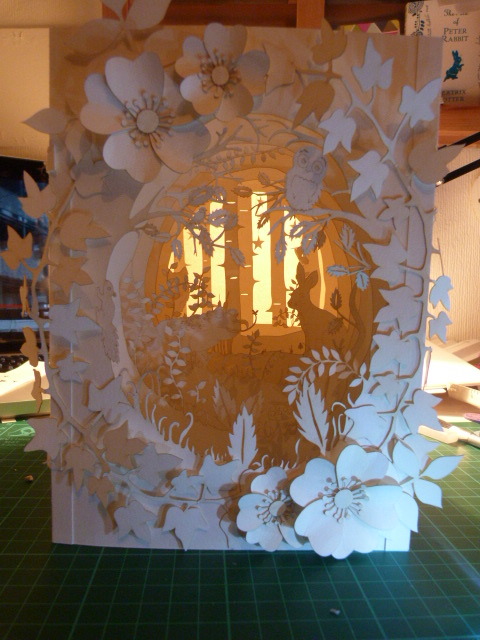
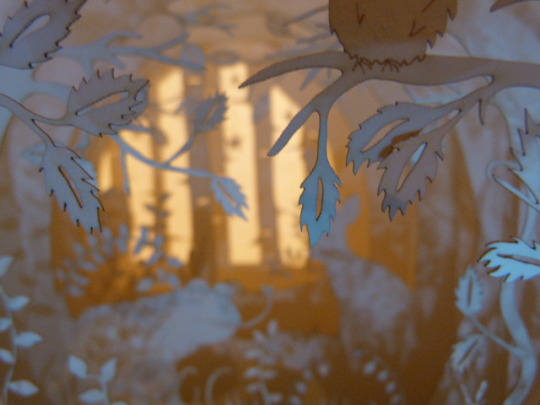
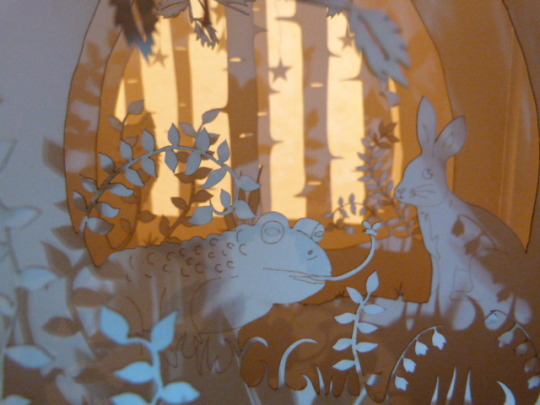
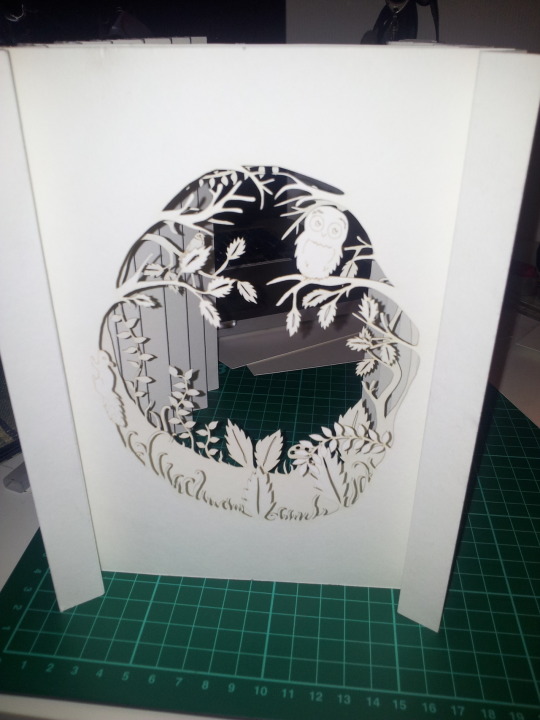

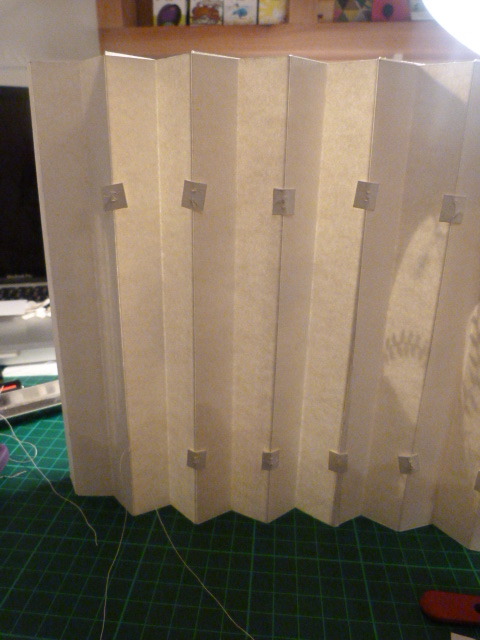
I took me a while to put my final piece together but I think I have finished it! I had to spend a lot of time aligning the layers and cutting them down to size, I then had to make the concertina side panelling and measure them out into sections to figure out the spacing between each of the layers and where to cut the tiny holes for the toggles. I then had to measure them against the layers to match the alignment of where the toggles will go. I then threaded the cotton threw which was a bit fiddly and tided on the toggles. This was probably the most time consuming part as it took forever! Once I had gotten all the layers in I decided to added a few dangling stars and a butterfly. I then used the decoration that I had also cut using the laser cutter to add to the outside of the first layer. I decided I wanted them to have a 3D feel as I almost wanted it to look as if they where creeping out of the piece. I enjoyed making the flowers 3D I found it quite relaxing and therapeutic. I am quite happy with the outcome there a few things with the aesthetics I would like to improve and change If I had more time to spend on the design. I have also attempted to play around with the lighting having it coming from behind and from different angles to create shadows.
11 notes
·
View notes
Photo
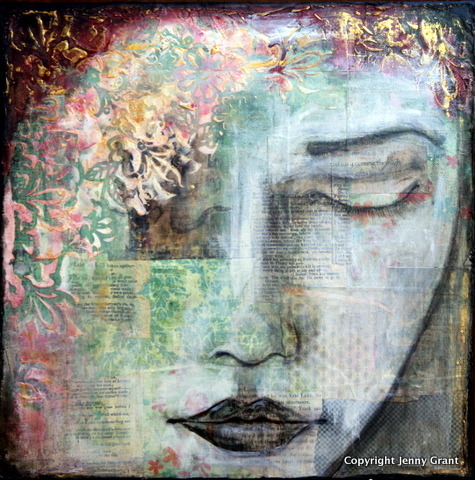
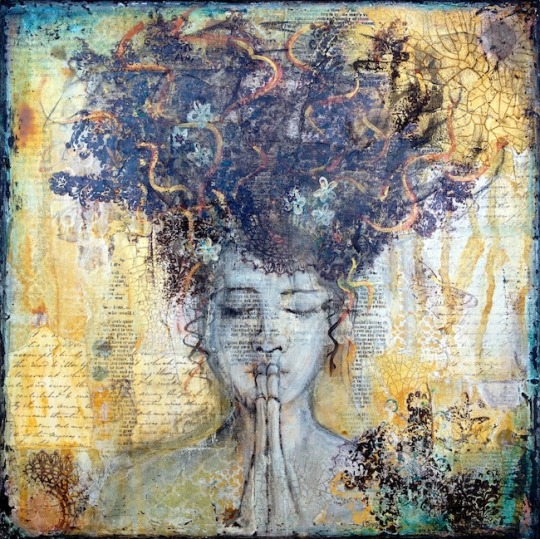
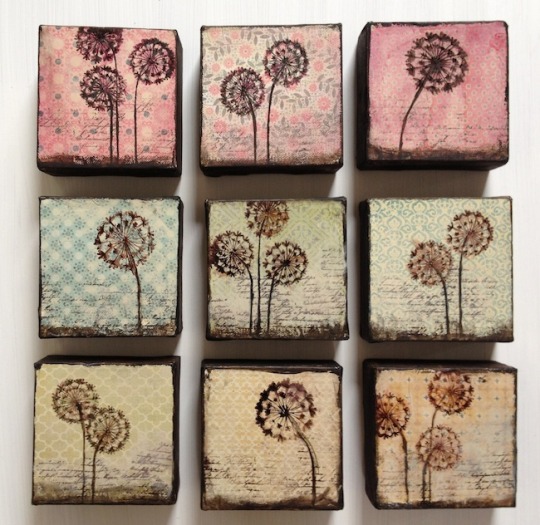
Jenny Grant
A mixed media artist that uses a range of materials such as pastels, papers, fabrics, paints and inks. Generally making it up as she goes along, adding different materials to her paintings without a set plan. Her art it rich with layers which add texture and depth.
0 notes
Text
Self-directed project thoughts
For this project, I decided I wanted to visually represent/illustrate Edgar Allan Poe stories. I want to create these photographs how I see them in my head when I read the stories like The Tell-Tale Heart and The Raven. I had this idea in class of week one and I really want to see how it would turn out. I'm not sure at this stage how I might do it right now, but I know it will definitely be staged.
That was my initial idea, and a few weeks ago I expanded upon that by deciding that I would illustrate just one story and make a series of that, telling the story scene by scene. For example, I want to create The Tell-Tale Heart visually, I would make photos of things like the old man's eye, the killer with the lantern, the slither of light falling on the eye, the man under the mattress, police at the door and then the killer freaking out over the beating of the heart.
I've done some research concerning how I would like these photos to look and I've found two artists I like; Nicola Kuperus and Gregory Crewdson. I will expand on each of these artists in future posts, but I like both of these styles and I will look to these artists' works for inspiration for this project.
0 notes
Photo
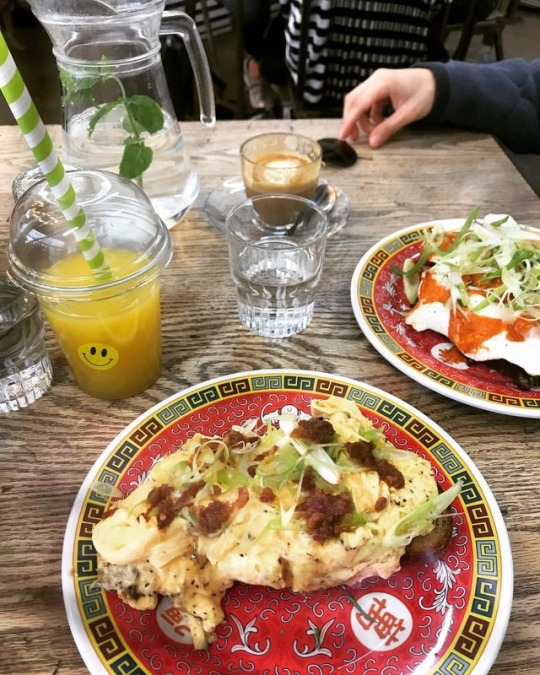
@olga_and_kay brunch before our meeting with the lovely @swarzymacaly. Watch this space guys...be things announcing soon 👩🏻💻👩🏽💻👨🏾💻💯 #creatives #collaboration #design #selfdirectedproject #graphicdesigner #photographer #shoreditch #brunch #foodporn #watchthisspace https://www.instagram.com/p/BnwDum4BYpC/?utm_source=ig_tumblr_share&igshid=17o79lyg7s50s
#creatives#collaboration#design#selfdirectedproject#graphicdesigner#photographer#shoreditch#brunch#foodporn#watchthisspace
0 notes
Photo
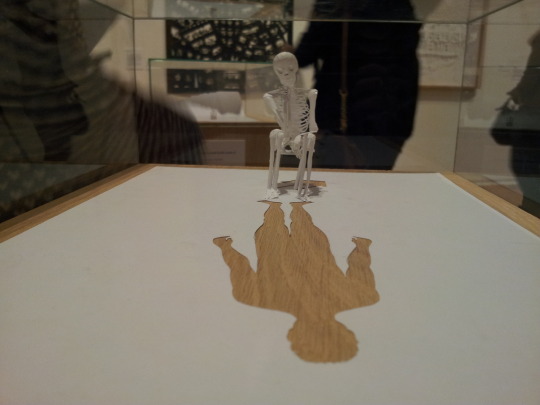
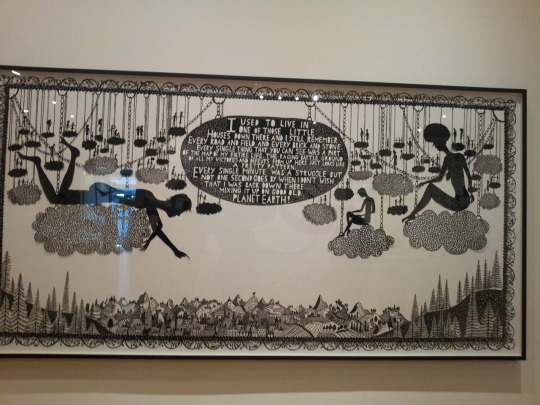

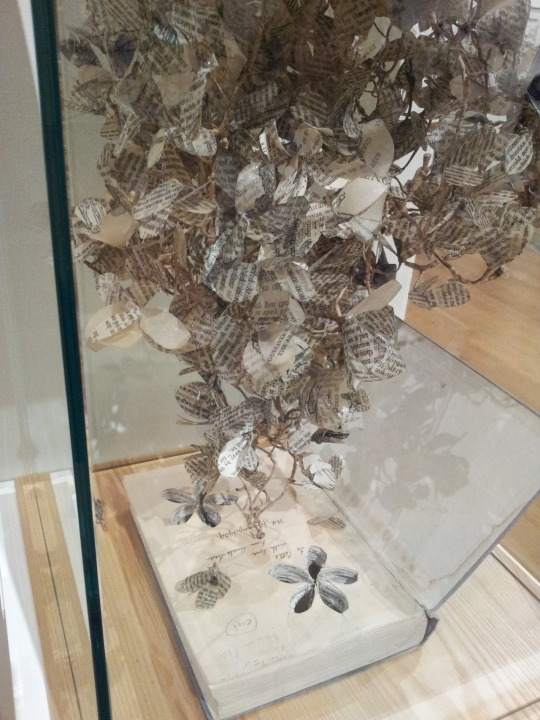
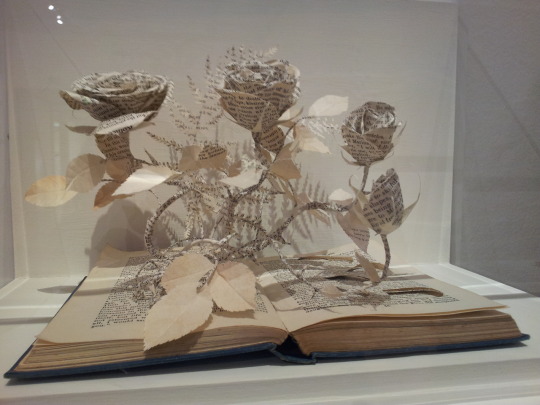
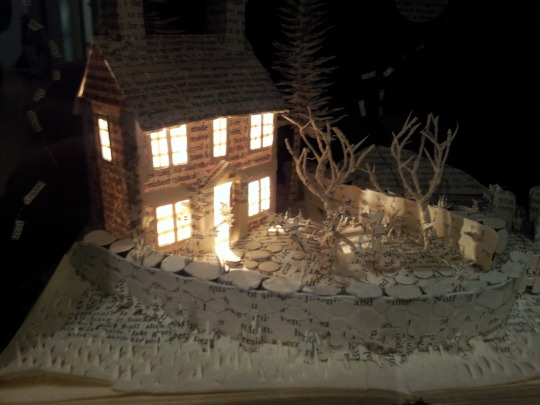
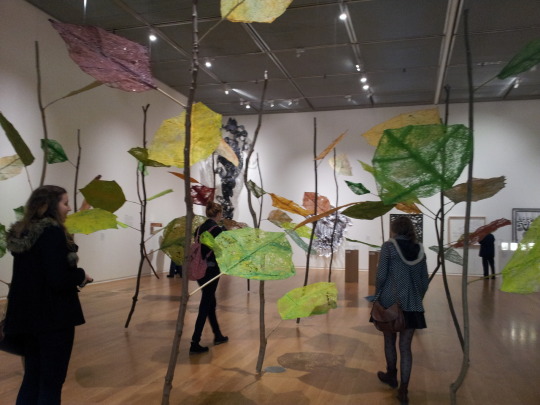
I managed to get down to the First Cut exhibition in Manchester and it was such a good decision to go it was the best one I had been to in awhile! All the work there was amazing, I have always been a fan of Su Blackwell and Rob Ryan and that was the first time I was able to see any of their pieces in real life. Plus there were other paper artists that I have come across through research in the past and was lucky enough to see some of their work too. Including amazing work by Peter Callesen. It was so interesting seeing how some of the pieces had been put together, you could really appreciate the delicateness and skill that went into some of the pieces by getting to see them first hand. There was an amazing video starring some of the artists talking about their work that featured in the exhibition, it was interesting to hear about their process and inspiration behind their pieces. I had a really lovely day out and even managed to pop in to the David Shrigley exhibition in the corner house. Overall a very successful day and feel like I have gained a lot of inspiration and new ideas on how to attack my personal project. I wouldn't hesitate about going again.
3 notes
·
View notes
Text
Connectionist Representation
Connectionist models provide a new paradigm for understanding how information might be represented in the brain. A seductive but naive idea is that single neurons (or tiny neural bundles) might be devoted to the representation of each thing the brain needs to record. For example, we may imagine that there is a grandmother neuron that fires when we think about our grandmother. However, such local representation is not likely. There is good evidence that our grandmother thought involves complex patterns of activity distributed across relatively large parts of cortex.
It is interesting to note that distributed, rather than local representations on the hidden units are the natural products of connectionist training methods. The activation patterns that appear on the hidden units while NETtalk processes text serve as an example. Analysis reveals that the net learned to represent such categories as consonants and vowels, not by creating one unit active for consonants and another for vowels, but rather in developing two different characteristic patterns of activity across all the hidden units.
Given the expectations formed from our experience with local representation on the printed page, distributed representation seems both novel and difficult to understand. But the technique exhibits important advantages. For example, distributed representations, (unlike symbols stored in separate fixed memory locations) remain relatively well preserved when parts of the model are destroyed or overloaded. More importantly, since representations are coded in patterns rather than firings of individual units, relationships between representations are coded in the similarities and differences between these patterns. So the internal properties of the representation carry information on what it is about (Clark 1993, 19). In contrast, local representation is conventional. No intrinsic properties of the representation (a unit's firing) determine its relationships to the other symbols. This self-reporting feature of distributed representations promises to resolve a philosophical conundrum about meaning. In a symbolic representational scheme, all representations are composed out of symbolic atoms (like words in a language). Meanings of complex symbol strings may be defined by the way they are built up out of their constituents, but what fixes the meanings of the atoms?
Connectionist representational schemes provide an end run around the puzzle by simply dispensing with atoms. Every distributed representation is a pattern of activity across all the units, so there is no principled way to distinguish between simple and complex representations. To be sure, representations are composed out of the activities of the individual units. But none of these ‘atoms’ codes for any symbol. The representations are sub-symbolic in the sense that analysis into their components leaves the symbolic level behind.
The sub-symbolic nature of distributed representation provides a novel way to conceive of information processing in the brain. If we model the activity of each neuron with a number, then the activity of the whole brain can be given by a giant vector (or list) of numbers, one for each neuron. Both the brain's input from sensory systems and its output to individual muscle neurons can also be treated as vectors of the same kind. So the brain amounts to a vector processor, and the problem of psychology is transformed into questions about which operations on vectors account for the different aspects of human cognition.
Sub-symbolic representation has interesting implications for the classical hypothesis that the brain must contain symbolic representations that are similar to sentences of a language. This idea, often referred to as the language of thought (or LOT) thesis may be challenged by the nature of connectionist representations. It is not easy to say exactly what the LOT thesis amounts to, but van Gelder (1990) offers an influential and widely accepted benchmark for determining when the brain should be said to contain sentence-like representations. It is that when a representation is tokened one thereby tokens the constituents of that representation. For example, if I write ‘John loves Mary’ I have thereby written the sentence's constituents: ‘John’ ‘loves’ and ‘Mary’. Distributed representations for complex expressions like ‘John loves Mary’ can be constructed that do not contain any explicit representation of their parts (Smolensky 1991). The information about the constituents can be extracted from the representations, but neural network models do not need to explicitly extract this information themselves in order to process it correctly (Chalmers 1990). This suggests that neural network models serve as counterexamples to the idea that the language of thought is a prerequisite for human cognition. However, the matter is still a topic of lively debate (Fodor 1997).
The novelty of distributed and superimposed connectionist information storage naturally causes one to wonder about the viability of classical notions of symbolic computation in describing the brain. Ramsey (1997) argues that though we may attribute symbolic representations to neural nets, those attributions do not figure in legitimate explanations of the model's behavior. This claim is important because the classical account of cognitive processing, (and folk intuitions) presume that representations play an explanatory role in understanding the mind. It has been widely thought that cognitive science requires, by its very nature, explanations that appeal to representations (Von Eckardt 2003). If Ramsey is right, the point may cut in two different ways. Some may use it to argue for a new and non-classical understanding of the mind, while others would use it to argue that connectionism is inadequate since it cannot explain what it must. However, Haybron (2000) argues against Ramsey that there is ample room for representations with explanatory role in radical connectionist architectures. Roth (2005) makes the interesting point that contrary to first impressions, it may also make perfect sense to explain a net's behavior by reference to a computer program, even if there is no way to discriminate a sequence of steps of the computation through time.
The debate concerning the presence of classical representations and a language of thought has been clouded by lack of clarity in defining what should count as the representational “vehicles” in distributed neural models. Shea (2007) makes the point that the individuation of distributed representations should be defined by the way activation patterns on the hidden units cluster together. It is the relationships between clustering regions in the space of possible activation patterns that carry representational content, not the activations themselves, nor the collection of units responsible for the activation. On this understanding, prospects are improved for locating representational content in neural nets that can be compared in nets of different architectures, that is causally involved in processing, and which overcomes some objections to holistic accounts of meaning.
In a series of papers Horgan and Tienson (1989, 1990) have championed a view called representations without rules. According to this view classicists are right to think that human brains (and good connectionist models of them) contain explanatorily robust representations; but they are wrong to think that those representations enter in to hard and fast rules like the steps of a computer program. The idea that connectionist systems may follow graded or approximate regularities (“soft laws” as Horgan and Tienson call them) is intuitive and appealing. However, Aizawa (1994) argues that given an arbitrary neural net with a representation level description, it is always possible to outfit it with hard and fast representation-level rules. Guarini (2001) responds that if we pay attention to notions of rule following that are useful to cognitive modeling, Aizawa's constructions will seem beside the point.
Via: http://plato.stanford.edu/entries/connectionism/#ConSemSim
0 notes
Link
Found such a brilliant blog this evening!
0 notes
Text
Project as a whole!
Overall i have really enjoyed this project and i have learned a lot throughout. It has made me want to carry on doing laser cut illustrations especially the paper laser cuts as i have really enjoyed doing this a lot and i think its a style of work I'm really interested in.
I have learned that I'm a lot more confident using Adobe Illustrator and also a lot more confident using Corel Draw as i had never used that before until starting this module. I felt that doing the self directed project helped a lot with learning the new software as i felt we were left to our own devices a lot and we could plan our time ourselves which helped fit around the other briefs we had to do. I thought it was really difficult as we had to use one of the words from our first illustration project to inspire us for this project. Luckily i felt i had a good idea from the start to work with, so i after i did a bit of research i decided to go with that it was just difficult to plan it out as i didn't know what it was going to look like until i did it. I did a few sketched but it wasn't until the mock up i had a real idea of what it was going to look like.
Overall i though the project worked really well and i felt the outcome was successful. The only things that i would change would be to change maybe the positioning of the tiger and maybe add a few more layers behind so its clearer as i feel the deer looks a lot better where as i wanted the tiger to be the main focus. I think the final outcome was successful and i thought the feeling i wanted it to create was portrayed as the branches gave it a haunting, creepy feeling which is what i wanted it to create.
I would like to carry on doing more laser cutting as i feel i am quite good at it and i think i would like to try different ideas and take ideas from artists such as Rob Ryan and then create my own.
0 notes
Text
The project as a whole!
Overall I thoroughly enjoyed this project I was so excited when I heard we had a laser cutting option as it was something I was fascinated with during a-level. I had never done a paper cut this way as I had originally only ever done hand cut pieces. At first I found it a bit challenging as I had forgotten how to put all the bits together on illustrator as we had been using a different system in school. During the component 1 stage of the module, I managed to get down to the First Cut exhibition in Manchester which was fascinating as there where artists work that I had always dreamed of seeing such as the king and queen of paper cutting, Rob Ryan and Su Blackwell, I also bought a book for paper cutting. These where the things that inspired me and got me really excited about this project. I began my design for the final piece quite early on which I am quite glad I did as it took me a while to get everything done properly on illustrator. That was the thing I learnt the most about as the longer I spent doing and designing my layers the more it made sense. After I had designed the layers I had to figure out the structure, I drew from some of the influences I had come across in the First Cut exhibition and figured out quite a sound structure using paper toggles. I had done a few test cuts to check out the stock of the paper and was quite lucky that the paper I had bought a lot of was perfect as it could withstand the frail fragile parts of the design. I was happy with this and the colour of the paper so I decided to cut my final layers. My most relaxing part of this project was constructing it and adding the little extras such as the butterflies and the stars. I also really enjoyed making the 3D flowers etc... Overall I was really pleased with how it came out. If i had the chance there would probably be a few alterations I would make such as keeping the design as just as a silhouette and taking away the laser markings, also some alterations to the design, other than that I am happy and really enjoyed it all.
1 note
·
View note
Photo
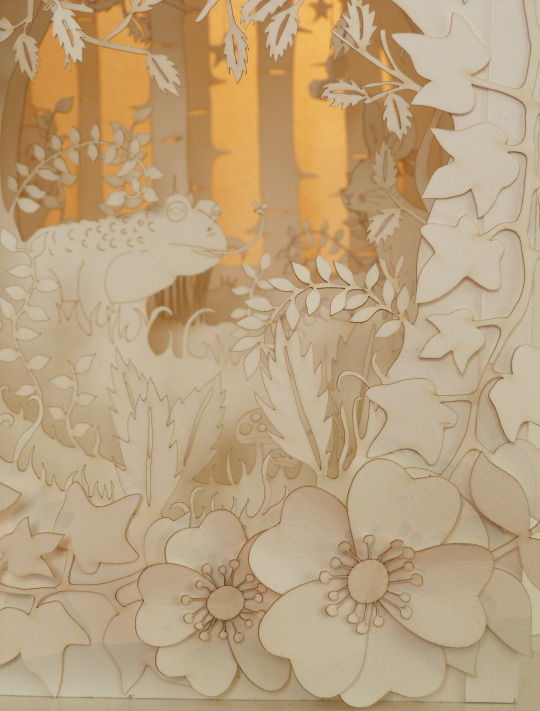
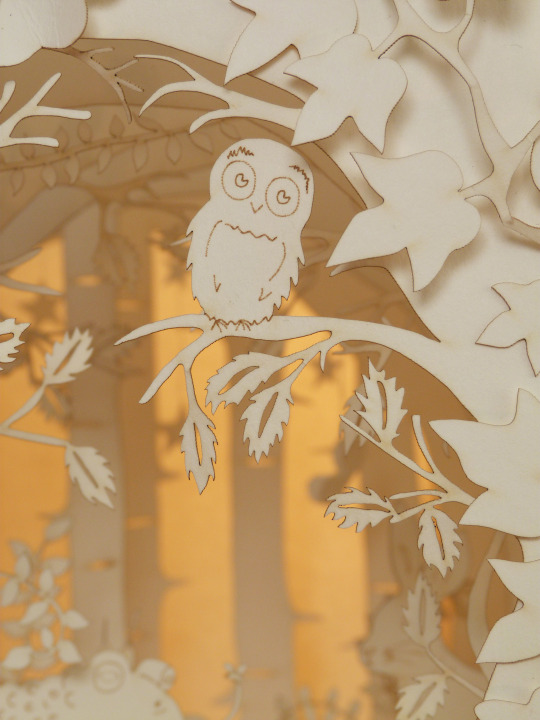
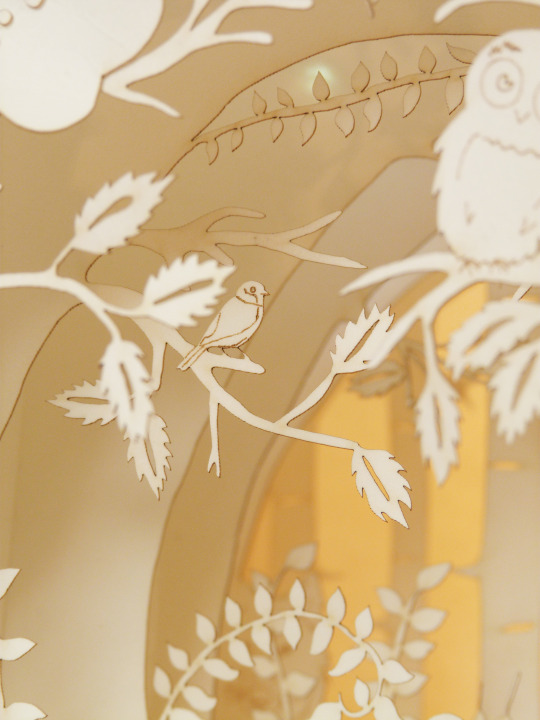
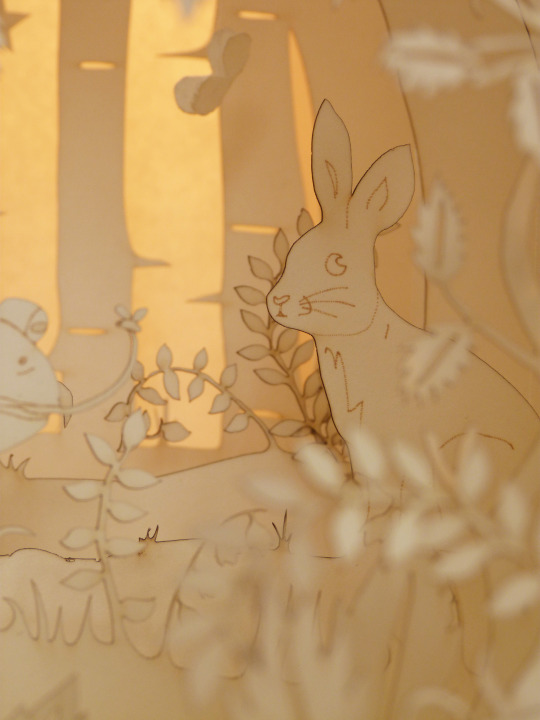
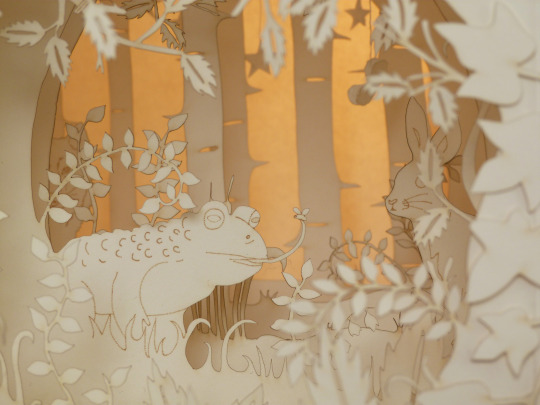
Here are some close up pictures of the paper cut. Including the likes of the bird thats hidden behind the branches.
1 note
·
View note
Photo
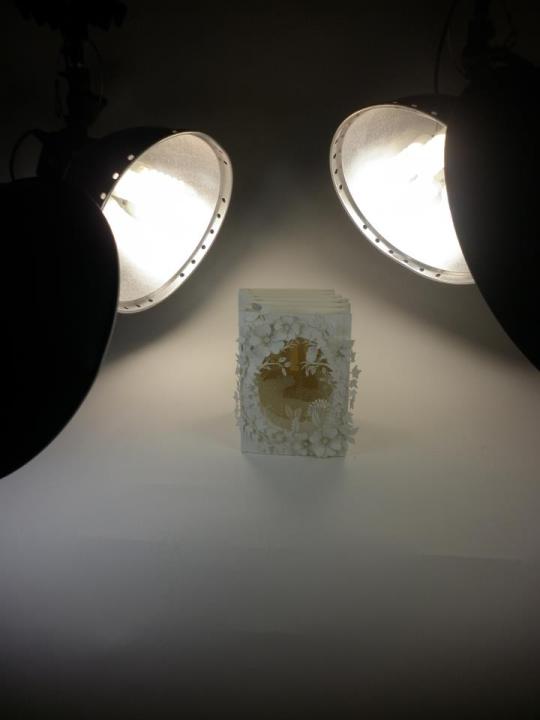
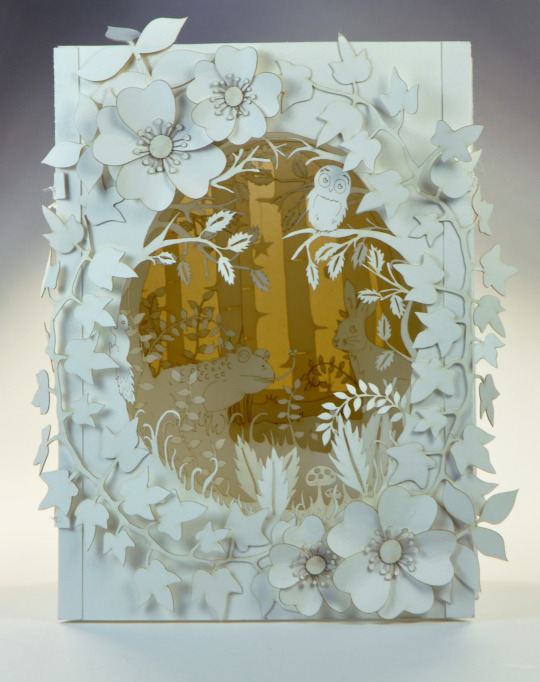
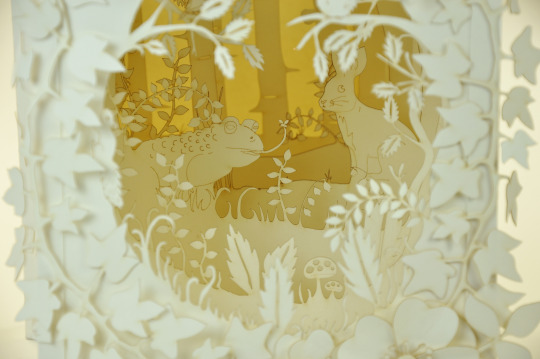
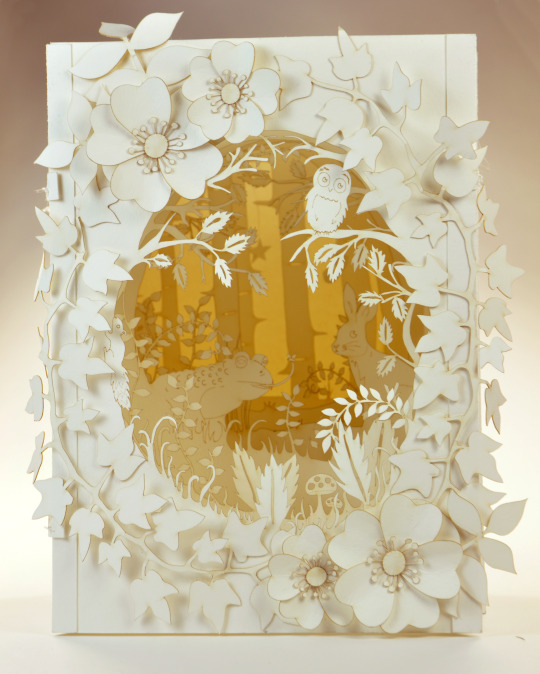

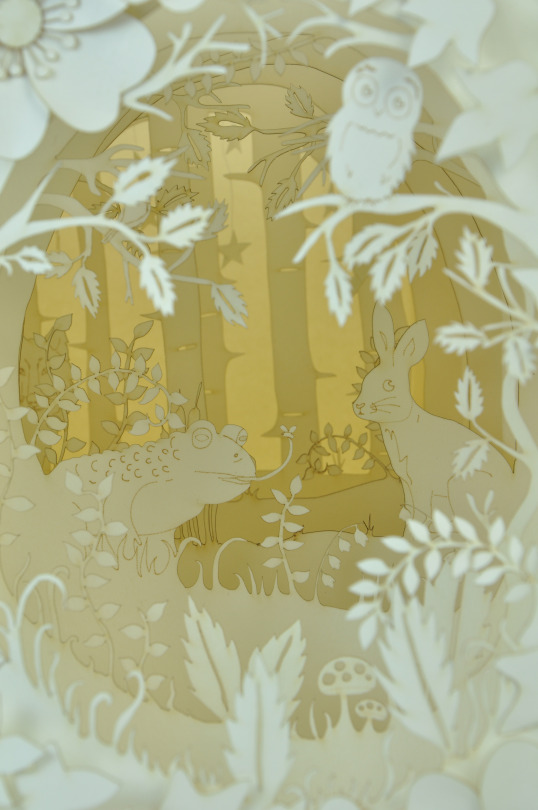
I took my piece into the photography room to see if I could get some professional lighting on it and use a better camera than the one I have got. It took a bit of messing with some of the lighting as the lamps where pretty big, but I was quite happy with the results. I really wanted the light to shine from behind the object as I had done some test photos at home and they looked really good. That seemed harder to achieve in the photography studio but I managed to get some really good lighting that showed of the detail. I was really happy that I managed to use the white back drop as it looks really affective. I also did try creating some of my own photos at home with some of the back lighting which I have included in the photos above, but my camera wasn't quite up to it. Although I am happy with them I do feel they don't look quite as good as the professional ones, its just a shame that the lights were not as warm as I had hoped. It was an extremely stressful day that took nearly all day in the photography studio but it was bar far worth it!
1 note
·
View note
Photo
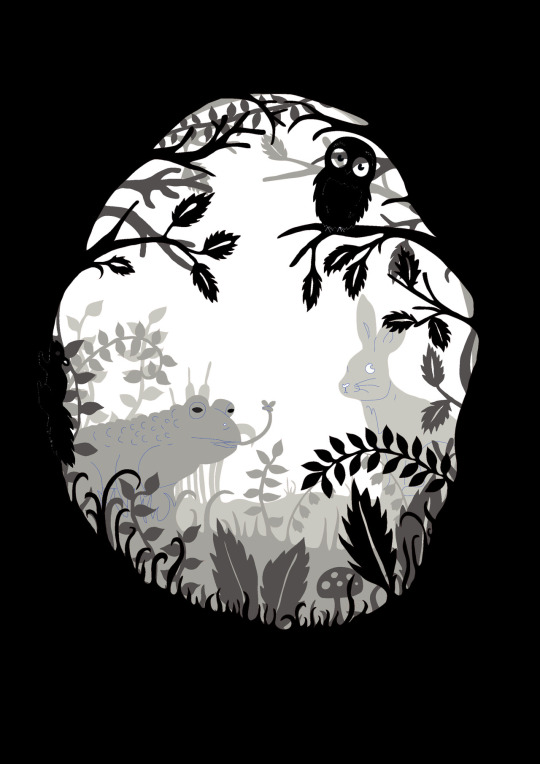
This is a photoshop test I have created to see what the layers will look like. Although I am not using all the different tones shown here as I will be using white paper and relying on natural light and space to create the depth. I just wanted to see what they will look like and have figured out all the different bits I will need to add and what is needed from the final couple of layers
1 note
·
View note
Text
Connectionism and Semantic Similarity
One of the attractions of distributed representations in connectionist models is that they suggest a solution to the problem of determining the meanings of brain states. The idea is that the similarities and differences between activation patterns along different dimensions of neural activity record semantical information. In this way, the similarity properties of neural activations provide intrinsic properties that fix meaning. However, Fodor and Lepore (1992, Ch. 6) challenge similarity based accounts on two fronts. The first problem is that human brains presumably vary significantly in the number of and connections between their neurons. Although it is straightforward to define similarity measures on two nets that contain the same number of units, it is harder to see how this can be done when the basic architectures of two nets differ. The second problem Fodor and Lepore cite is that even if similarity measures for meanings can be successfully crafted, they are inadequate to the task of meeting the desiderata which a theory of meaning must satisfy.
Churchland (1998) shows that the first of these two objections can be met. Citing the work of Laakso and Cottrell (2000) he explains how similarity measures between activation patterns in nets with radically different structures can be defined. Not only that, Laakso and Cottrell show that nets of different structures trained on the same task develop activation patterns which are strongly similar according to the measures they recommend. This offers hope that empirically well defined measures of similarity of concepts and thoughts across different individuals might be forged.
On the other hand, the development of a traditional theory of meaning based on similarity faces severe obstacles (Fodor and Lepore 1999), for such a theory would be required to assign sentences truth conditions based on an analysis of the meaning of their parts, and it is not clear that similarity alone is up to such tasks as fixing denotation in the way a standard theory demands. However, most connectionists who promote similarity based accounts of meaning reject many of the presupposition of standard theories. They hope to craft a working alternative which either rejects or modifies those presuppositions while still being faithful to the data on human linguistic abilities.
Calvo Garzon (2003) complains that there are reasons to think that connectionists must fail. Churchland's response has no answer to the collateral information challenge. That problem is that the measured similarities between activation patterns for a concept (say: grandmother) in two human brains are guaranteed to be very low because two people's (collateral) information on their grandmothers (name, appearance, age, character) is going to be very different. If concepts are defined by everything we know, then the measures for activation patterns of our concepts are bound to be far apart. This is a truly deep problem in any theory that hopes to define meaning by functional relationships between brain states. Philosophers of many stripes must struggle with this problem. Given the lack of a successfully worked out theory of concepts in either traditional or connectionist paradigms, it is only fair to leave the question for future research.
0 notes
Photo
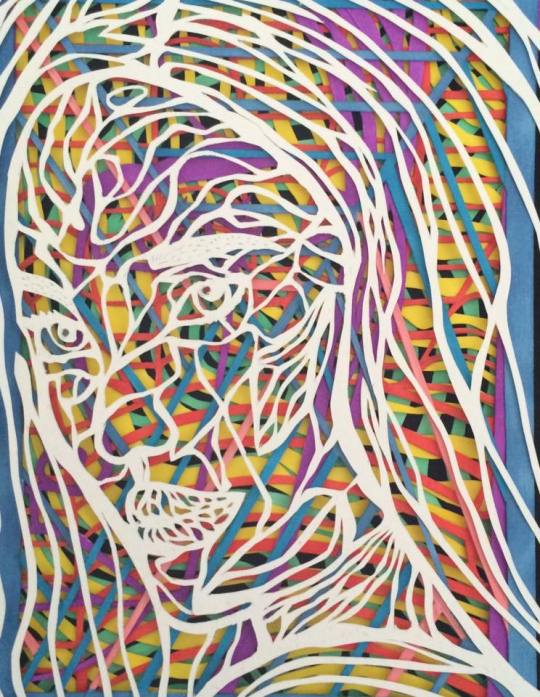
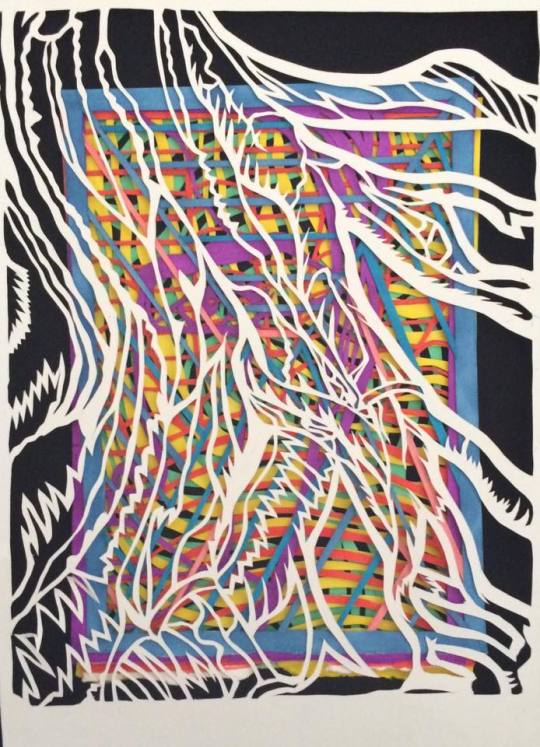
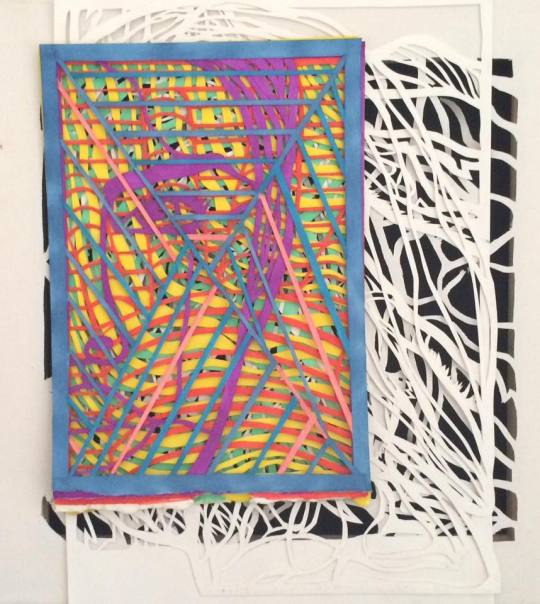
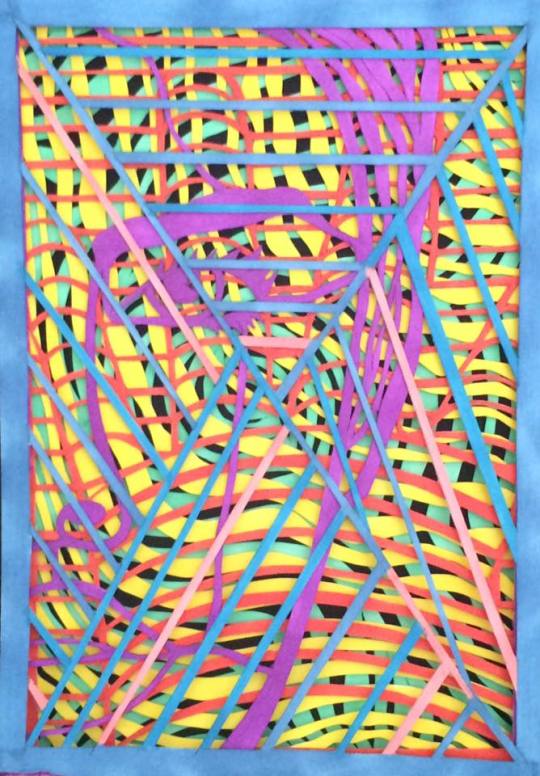
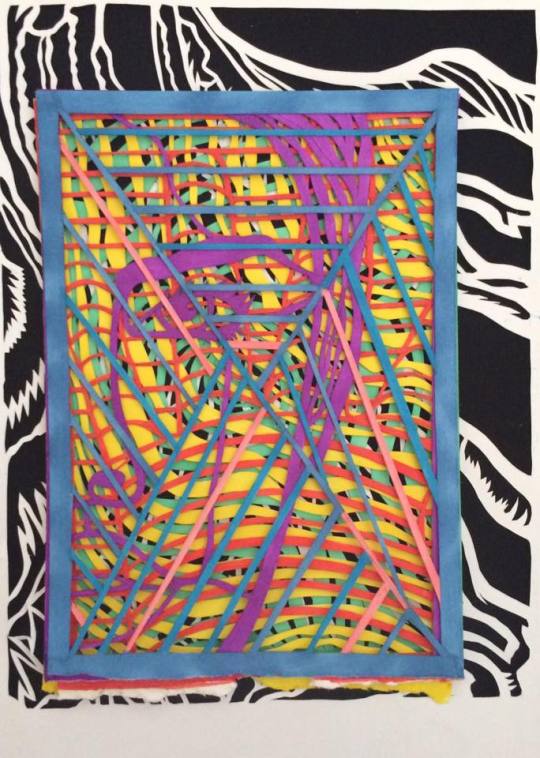
Development
Experimenting ways to arrange the paper cuts I have made as I don’t like them on their own.
I like these ones the best but will have to find a better way to display them because they have no real border as you can see on picture 3..
0 notes
Photo
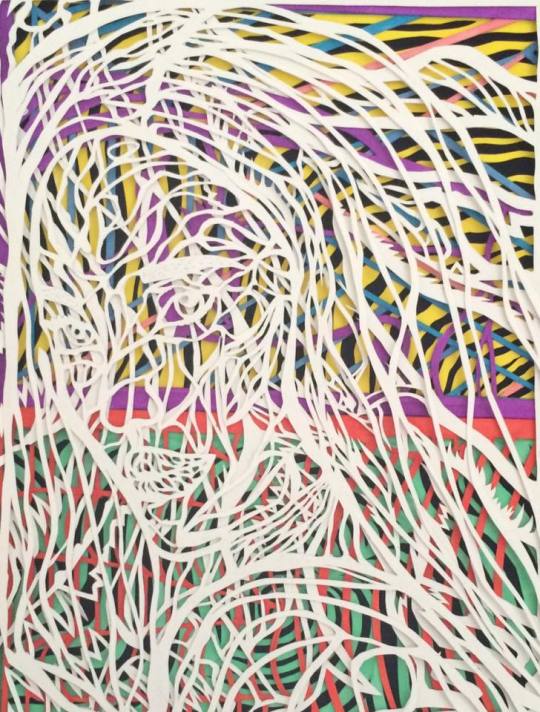
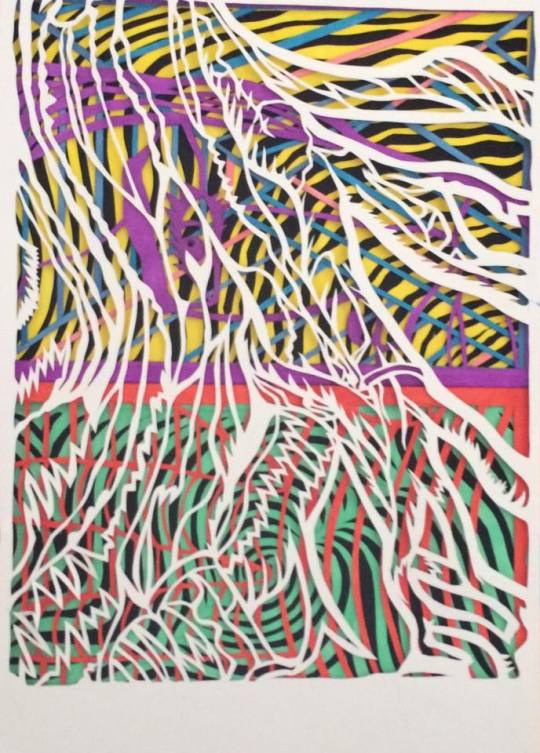
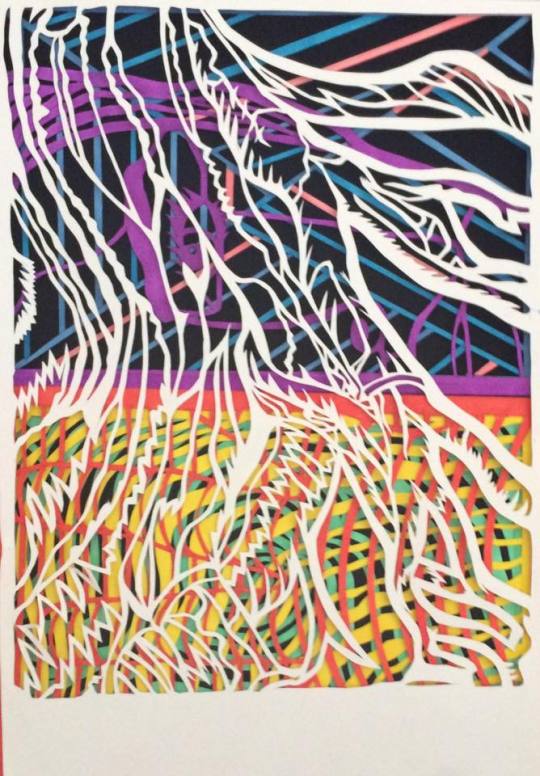
Development
Experimenting ways to arrange the paper cuts I have made as I don’t like them on their own.
I quite like how much the white contrasts the colour on these ones
0 notes